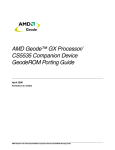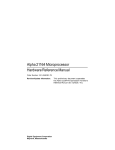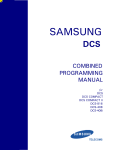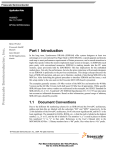Download AMD CS5536 User's Manual
Transcript
AMD Geode™ LX Processor DDR2 BIOS Porting Guide 1.0 Scope The AMD Geode™ LX processor has an integrated DDR memory controller. Due to the concerns over the availability and increasing cost of DDR, AMD has developed a method for operating DDR2 memory with the processor’s memory controller. This application note details the software changes necessary to enable this technology. Note: The solution described in this document does not conform to the JEDEC DDR2 Specification. This solution may not work with all DDR2 memory. Note: This is revision B of this document. The change from revision A (also dated March 2009) is “AMD Confidential” was removed. 2.0 Description Initializing DDR2 SDRAM requires writing to additional mode registers. In addition to the Mode Register (MR) and Extended Mode Register (EMR), DDR2 defines two new Extended Mode Registers, EMR(2) and EMR(3). The EMR is renamed as EMR(1). Furthermore, the MR and EMR definitions are not an exact match between DDR and DDR2. Table 2-1 shows a comparison of the typical initialization steps for DDR vs. DDR2. Addressing MR vs. EMR(1), EMR(2) or EMR(3) is determined by the states of BA[2:0] while the LOAD MODE command is presented on the control signals. The data written to the registers is the pattern presented on A[15:0] when the command is initiated. (Note, however, that A[15:13]=0, and BA[2]=0 in all cases.) Software on the LX processor issues LOAD MODE commands by writing the MC_CF07_DATA register. During the operation, the memory controller (MC) uses various bits and fields in the MC_CF07_DATA and MC_CF8F_DATA registers. With the available settings, the LX processor is not capable of generating the necessary signal patterns for all the required LOAD MODE commands. 46959A - March 2009 Table 2-1. Initialization Steps DDR DDR2 Wait a minimum of 200µs after clocks and power are stable, then assert CKE. Wait a minimum of 200µs after clocks and power are stable, then assert CKE. Wait a minimum of 400ns, then issue a PRECHARGE ALL command. Wait a minimum of 400ns, then issue a PRECHARGE ALL command. Issue a LOAD MODE command to EMR(2) Issue a LOAD MODE command to EMR(3). Issue a LOAD MODE command to EMR to enable the DLL. Issue a LOAD MODE command to EMR(1) to enable the DLL. Issue LOAD MODE command to MR with DLL reset. Issue LOAD MODE command to MR with DLL reset. Wait at least 200 clock cycles. Issue a PRECHARGE ALL command. Wait at least 200 clock cycles. Issue a PRECHARGE ALL command. Issue two REFRESH commands. Issue two REFRESH commands. Issue LOAD MODE to MR without DLL reset. Issue LOAD MODE to MR without DLL reset. Issue LOAD MODE to EMR(1) with OCD default. Issue LOAD MODE to EMR(1) with OCD exit. SDRAM initialization is complete. SDRAM initialization is complete. 1 Application Note 46959A - March 2009 3.0 Solution The method for initializing DDR2 memory on the processor is to insert a CPLD and quick switches in the address and BA signals. Figure 3-1 shows a block diagram of this design. During initialization, the Enable signal opens (default) the switches. BIOS tells the CPLD what pattern to assert on the BA[n] and A[n] signals. Upon completion, BIOS tells the CPLD to close the switches, giving control over BA[n] and A[n] to the processor. Additional physical and electrical details of the design are beyond the scope of this document. 3.1 Hardware This section explains the details of the initialization. First it’s important to delineate two unique versions of this hardware technology. 3.1.1 On-DIMM Design This hardware form-factor has a DDR pin assignment (only SO-DIMM as of this writing), but contains DDR2 SDRAM modules, and the CPLD. This type of design will be attractive for customers wanting to upgrade existing systems. The only board change required is a lower memory voltage. Because the CPLD is contained on the DIMM assembly, the only bus available for communication is I2C. The CPLD’s I2C address is A0/A1 (i.e., the same as DIMM0). The CPLD also contains the SPD information. Also note that the CPLD uses CKE as its RESET# signal. As a result, the list of BIOS changes may require moving the assertion of CKE (e.g., if the SPD is accessed prior to CKE). 3.1.2 On-board Design This type of system will have the CPLD soldered onto the motherboard, and will be able to use certain off-the-shelf (OTS) DDR2 DIMMs. In this case, the CPLD does not contain SPD information. Because the communication is not limited to I2C, using I/O to send data to the CPLD simplifies the CPLD design and speeds up initialization. The I/O addresses selected for the AMD Geode™ LX Processor Refresh Reference Design Kit (RDK) board are AC10h and AC11h. This requires a modification to the Virtual PCI portion of the BIOS to identify the I/O range to an operating system. As of this writing, the CPLD claims a range of 8 bytes (i.e., AC10h-AC17h). A[13] A[15:14], BA[2] A[12:0], BA[1:0] AMD Geode™ LX Processor / CS5536 DDR2 SDRAM Quick Switches Enable A[12:0], BA[1:0] I2C CPLD Figure 3-1. AMD Geode™ LX Processor DDR2 Block Diagram 2 AMD Geode™ LX Processor DDR2 BIOS Porting Guide Application Note 46959A - March 2009 3.2 CPLD Registers The CPLD contains two registers that indicate how it should assert the BA[1:0], A[12:0] signals and switch enable signals. • If accessing the registers via I2C, the register addresses are 80h and 81h. • If accessing with I/O, the addresses are AC10h and AC11h. The two registers are defined in Table 3-1 and 3-2. Instructing the CPLD to set or clear a signal causes the behavior to occur immediately on its outputs. Prior to executing a LOAD MODE command, the BIOS sets the CPLD registers to the desired pattern. The DRAM registers are programmed with the A[n] signals. The register being initialized is determined by the pattern on BA[1:0] (MR=00b, EMR(1)=01b, EMR(2)=10b and EMR(3)=11b). Then the BIOS generates the LOAD MODE command by setting, and then clearing, the PROG_DRAM bit in the MC_CF07_DATA register. AMD also recommends setting the MSR_BA field (same register) to the desired BA[1:0] levels (same procedure as initializing DDR). Table 3-1. REG_A Definition Bit Name Description 7 A[7] Address signal 7. If SW_EN# is high, setting this bit causes the CPLD to assert the A[7] signal. This behavior is consistent for all the A[n] and BA[n] fields. 6 A[6] Address signal 6 5 A[5] Address signal 5 4 A[4] Address signal 4 3 A[3] Address signal 3 2 A[2] Address signal 2 1 A[1] Address signal 1 0 A[0] Address signal 0 Table 3-2. REG_B Definition Bit Name Description 7 SW_EN# Switch enable. When high, the CPLD asserts all of its A[n] and BA[n] signals, according to the current settings in the internal registers. When low, the CPLD closes the switches and tri-states its A[n] and BA[n] signals. 6 BA[1] Bank Address 1 5 BA[0] Bank Address 0 4 A[12] Address signal 12 3 A[11] Address signal 11 2 A[10] Address signal 10 1 A[9] Address signal 9 0 A[8] Address signal 8 AMD Geode™ LX Processor DDR2 BIOS Porting Guide 3 Application Note 46959A - March 2009 3.3 Initialization Steps Some of the following steps may be optional, depending on the specific implementation. The reader is encouraged to have a copy of the JEDEC standard for DDR2 SDRAM, including the SPD byte definitions. The AMD Geode™ LX Processors Data Book, order# 33234, is also recommended. The chapters for the memory controller and GeodeLink™ Control Processor (GLCP) register definitions will be useful. Calculate the size of each DIMM. SPD[31] indicates the density of each rank and it is defined differently than in the DDR specification. Multiply this by the number of ranks from SPD[5] to find the DIMM size. This value is used to program the Dn_SZ fields. Calculate the page size (i.e. the size of each row) for each DIMM. The page size is defined as: DIMM width * 2(# of columns) 3.3.1 Memory Controller Initialization 1) Enable the CKE signal earlier, if necessary. With the On-DIMM solution, this allows the CPLD to come out of reset. The CPLD cannot respond to any SPD reads while in the reset state. 2) Identify whether the installed DIMM(s) are DDR2. The information in SPD[2] (i.e., SPD byte number 2) indicates the fundamental memory type. If this value equals 8, then the memory type is DDR2. A mixture of memory types is not supported and the BIOS should not allow this configuration. 3) Program the memory speed by setting the appropriate dividers in the GLCP_SYS_RSTPLL register. This may be decided by retrieving data from NVRAM, from jumpers, or by calculating the best speed dynamically. If dynamic, the BIOS should set the memory speed slow enough to support the installed memory. The memory’s minimum cycle time is indicated in SPD[9], which has additional bits defined beyond the DDR specification. If more than one DIMM is installed, the slower of the two memories should be used in calculating the memory frequency. Note that if setting the speed dynamically, certain configurations should be avoided. These are unrelated to the memory technology installed. As is the case with DDR, the core frequency must never be lower than the GLIU frequency. The BIOS should try to avoid setting an unsupported GLIU frequency. 4) Determine the physical configuration of the installed DIMM(s). This procedure populates the fields in b[63:32] of the MSR_CF07_DATA register. SPD[5] indicates the number of ranks on the DIMM assembly. Note that DDR2 defines this SPD byte differently than the DDR spec. The LX processor’s memory controller only supports DIMMs with 1 or 2 ranks (indicated by 0 or 1). This setting determines the value in the Dn_MB fields (i.e., D0_MB and D1_MB fields). SPD[17] indicates the number of component banks. The LX processor’s memory controller only supports 2 or 4 banks, but DDR2 devices may support 4 or 8. The Dn_CB fields should be programmed with a 1 to indicate 4 banks. The BIOS should not allow configurations indicating 8 banks. 4 SPD[4] indicates the number of column addresses. The width should always be 8 bytes, but may also be read from SPD[6]. The LX processor’s memory controller only supports memory configurations that are 64 bits wide. The size is used to program the Dn_PSZ fields. 5) Calculate the CAS# Latency (CL) and Write Latency (WL). The WL is set with the WR2DAT field of the MC_CF1017_DATA register. This is a change from DDR to DDR2. With DDR technology WL=1, but for DDR2 the WL=CL-1. As of this writing, the memory controller may only operate at WL=1 (i.e., WR2DAT may only be programmed to equal 1). This condition forces all implementations to use a CAS# Latency of 2. A typical CAS# Latency algorithm should use the data in SPD[18], which is a bitmap of supported CL settings (in units of memory clocks). The bitmap will have up to 3 bits set, representing (from most significant to least) CL=X, CL=X-1 and CL=X-2, which is different than the DDR definition. Additionally, SPD[9], SPD[23] and SPD[25] will have the minimum cycle times at the highest CAS# Latency setting, the next lower setting, and second lower setting. Note that all cycle times have additional bits defined in the DDR2 specification. Normally, if two DIMMs are present, the algorithm should set the lowest number that is supported by both DIMMs at the current operating frequency. The process would be identical to DDR, however, it is simplified for DDR2 memory because of the requirement to operate at CL=2. In the event that SPD[18] does not indicate a supported CAS# Latency of 2, the BIOS may still take some steps to determine if CL=2 is supportable. The fundamental CAS# access time may be calculated using the supported CAS# Latencies and their associated cycle times. Multiplying the number of clocks by the cycle time equals the access time. Use the lowest result from all the supported CL values. Then divide this number by 2 to get the lowest cycle time supportable at CL=2. If the cycle time of the memory clock is greater than or equal to this value, then CL=2 is typi- AMD Geode™ LX Processor DDR2 BIOS Porting Guide Application Note 46959A - March 2009 cally supportable. As an example, consider the following DIMM characteristics: CAS# Latency Min Cycle Time (ns) Max Cycle Time (ns) CL=5 CL=4 CL=3 3.0 3.75 5.0 8.0 8.0 8.0 3.3.2 1) Also, set REF_STAG in MC_CF07_DATA to 4 clocks. 2) This is has a fundamental access time of 15ns, and therefore at CL=2, the minimum cycle time should be 7.5ns. This DIMM should be function normally at 133MHz, with a CL setting of 2. 6) Program the CAS_LAT field of the MC_CF8F_DATA register with the CAS# Latency value (i.e., 2). Additional settings are programmed in the same register: TRUNC_DIS: This forces bursts of 4, preventing bursts of 2 (unsupported in DDR2) Program the memory controller with the appropriate latencies for the memory. For DDR2, this step is nearly identical to DDR technology. As a result, this document will not go into many details. The memory controller settings affected are fields in the MC_CF8F_DATA register, and are determined by SPD data: Field ACT2PRE PRE2ACT ACT2CMD ACT2ACT ACT2ACTREF REF2ACT* Timing Parameter SPD Byte tRAS tRP tRCD tRRD tRC tRFC 30 27 29 28 41/40** 42/40** 3) Program other timing control parameters. In the MC_CF1017_DATA register: WR_TO_RD (tWTR) should be set for 2 clocks. RD_TMG_CTL should be set for 4 half-GLIU clocks 9) Set the drive strength control (EMR_DRV in MC_CF07_DATA) to Reduced if the DIMM(s) support it. This feature is indicated in SPD[22], bit 0. The memory controller is now set up correctly, and is prepared for turning on the memory. Now follow the DDR2 memory initialization steps (as outlined Table 2-1 on page 1). AMD Geode™ LX Processor DDR2 BIOS Porting Guide Issue a LOAD MODE command to EMR(2). First set the CPLD’s registers. Typical settings are REG_A=00h and REG_B=C4h. The setting in REG_B is SW_EN#=1, BA[1:0]=10b, and A[10]=1. Next, in MC_CF07_DATA register, set MSR_BA to 10b and PROG_DRAM to 1. Then clear PROG_DRAM and FORCE_PRE. Note that DDR2 defines A[10] of EMR(2) should be programmed to 0. Setting A[10]=1 for the PRECHARGE ALL step causes a violation of the spec during the LOAD MODE command. However, AMD has not observed any side effects of programming EMR(2) with A[10]=1. 4) Issue a LOAD MODE command to EMR(3). Similar to the previous step, set the CPLD’s registers. Typical settings are REG_A=00h and REG_B=E0h. The setting in REG_B is SW_EN#=1, BA[1:0]=11b. Next, in MC_CF07_DATA register, set MSR_BA=11b and PROG_DRAM=1. Then clear PROG_DRAM. 5) Issue a LOAD MODE command to EMR(1) to enable the DLL. Program the CPLD with the appropriate information for the EMR(1) definition. Note that in certain cases, it might be appropriate to leave the DLL disabled to allow the DRAM to run at lower frequencies. AMD does not recommend omitting this step, however. * REF2ACT is in the MC_CF1017_DATA register. **Contains an extension value, new for DDR2. 8) Issue a PRECHARGE ALL command. The memory controller does not allow software to issue a single PRECHARGE ALL command. Instead, the command is inserted before a REFRESH or a LOAD MODE command. Set the FORCE_PRE bit in the MC_CFCLK_DBUG register to insert the PRECHARGE ALL. Additionally, the PRECHARGE ALL command requires that A[10] be set high. This presents a minor architectural problem. The BIOS will not have the opportunity to modify A[10] between the PRECHARGE ALL command and the subsequent LOAD MODE command. So the CPLD must be prepared for the LOAD MODE command to EMR(2) (i.e., the A[n] and BA[n] bits set in its registers) and A[10] also set to high. THZ_DLY: This adds 1 clock to the Read-Write turnaround time 7) SDRAM Initialization CKE may have already been asserted, due to the requirement of the On-DIMM CPLD. If not, assert CKE by clearing the MASK_CKEn bit(s) in the MC_CFCLK_DBUG register. CKE needs to be asserted for at least 400ns before executing step 2. DLL Enable is defined in b[0] of the EMR(1) register. The desired setting goes into REG_A[0]. Also, the setting for the drive strength control goes into REG_A[1]. If previously set up, these two bits may be retrieved from the MC_CF07_DATA register. All other A[n] bits in 5 Application Note 46959A - March 2009 the CPLD are typically 0. Set SW_EN# high and BA[1:0] to 01b. Next, in MC_CF07_DATA register, set MSR_BA=01b and PROG_DRAM=1. Then clear PROG_DRAM. 6) Issue a LOAD MODE command to MR to reset the DLL. Regardless of whether the DLL is running, AMD does not recommend omitting this step. Some memory devices require A[8]=1 and all other A[n]=0 during this step. The JEDEC spec does not indicate zeroing all other address pins. Therefore, it is up to the BIOS to decide how to proceed during this step. The other fields in the MR may be constructed from existing settings in the MC. Similar to the other LOAD MODE commands, set SW_EN#=1 and BA[1:0]=00b. In the memory controller, set MSR_BA=00b and PROG_DRAM=1. Then clear PROG_DRAM. 7) Wait 200 clock cycles, then issue a PRECHARGE ALL command. As before, set the CPLD registers so that A[10] will be high and all other A[n] signals are inconsequential. Keep SW_EN# high. Set the FORCE_PRE bit in the MC_CFCLK_DBUG register to insert the command before the subsequent step. 8) Generate two REFRESH commands by twice setting then clearing the REF_TST bit in the CM_CF07_DATA register. Clear the FORCE_PRE bit between the two REFRESH commands to avoid an extra PRECHARGE ALL command. 9) Issue a LOAD MODE command to MR to bring the DLL out of reset. In the CPLD, set A[8]=0. Other A[n] settings may need to be calculated. – The burst length is in the MC_CF8F_DATA register as TRUNC_DIS. Of course, 4 is the only common setting, so this part may be abbreviated. – The CAS# Latency may also be retrieved from the MC_CF8F_DATA register. Due to the memory controller restriction, this may be otherwise hardcoded to 2. 11) Issue a LOAD MODE command to EMR(1) to exit OCD programming. A[1:0] (driver strength and DLL enable) are retrieved from MC_CF07_DATA. Set A[9:7]=000b for OCD default. Set SW_EN#=1 and BA[1:0]=01b. In MC_CF07_DATA set MSR_BA=01b and PROG_DRAM=1. Then clear PROG_DRAM. 12) Now the BIOS is finished with the CPLD and should give control of the A[12:0] and BA[1:0] signals to the memory controller. Write any value to REG_B with SW_EN#=0. 13) Program the refresh rate in the REF_INT field of MC_CF07_DATA. This process is identical to that used with DDR technology. Each DIMM indicates its supported rate in SPD[12]. The BIOS determines an interval that is sufficiently short for both DIMMs. Note, however, that the location for this step has moved for DDR2. The reason is that I2C accesses to an On-DIMM CPLD are very slow. If REF_INT is programmed earlier, the memory controller generates REFRESH commands during the initialization sequence. This disrupts initialization and prevents the DRAM from operating properly. There are some additional settings recommended by AMD. • Typically the GLCP_DELAY_CONTROLS register is set up very early in POST, and usually with hardcoded values. AMD recommends an initial setting of F2F100FF_56960304 in this register. • If there is no DIMM1, the SDCLK[5,3,1] should be disabled in the GLCP_DELAY_CONTROLS register. Set b[55] to do this. • Program the PMode Sensitivity Counter values in the MC_CF_PMCTR register. Typical values are PMode0 counter set to 0 for most aggressive, and PMode1 counter set to 200h. • Program the PMode1 Up Delay field of MC_CF1017_DATA to 209 clocks. – The Write Recovery for Autoprecharge field is calculated using information in SPD[36], which is new for DDR2. Set SW_EN#=1 and BA[1:0]=00b. In the memory controller, set MSR_BA=00b and PROG_DRAM=1. Then clear PROG_DRAM. 10) Issue a LOAD MODE command to EMR(1) with OCD set to Default. A[1:0] (driver strength and DLL enable) are retrieved from MC_CF07_DATA. Set A[9:7]=111b for OCD default. Set SW_EN#=1 and BA[1:0]=01b. In MC_CF07_DATA set MSR_BA=01b and PROG_DRAM =1. Then clear PROG_DRAM. 6 AMD Geode™ LX Processor DDR2 BIOS Porting Guide Application Note 46959A - March 2009 3.4 Other Information and Restrictions The LX processor/DDR2 solution does not do DQS training. The LX processor’s memory controller does not have the adjustability to make this worthwhile, and the speeds are slow enough that this is not a problem. Supporting CL=2 at higher frequencies implies that the memory must be of higher performance. To run the memory at 166MHz, this means that the memory should have an access time of 12ns. 133MHz requires 15ns. The memory must be organized with 4 component banks. This means that only 512Mbits, and lower, devices are supported. In addition, the memory controller only supports 1 or 2 ranks. Any other configurations should be avoided. The typical LX processor/DDR2 implementation will run the memory at lower frequencies than average. While 166MHz is within the DDR2 specification, some memory vendors may recommend operating with the DLL disabled. The customer should investigate this with their memory supplier. The DRAM must support a CAS# Latency of 2 clocks. A DIMM’s SPD may not indicate that this is supported, due to the higher typical operating frequencies of the memory. The BIOS may determine that CL=2 is possible by considering the fundamental access time of the memory (i.e., cycle time multiplied by the normal CAS# Latency). The reason for this restriction is that the LX processor’s memory controller must operate with a Write Latency of 1 clock. DDR2 defines CAS# Latency equal to Write Latency + 1. AMD Geode™ LX Processor DDR2 BIOS Porting Guide Some DRAM modules may operate at higher frequencies by raising their supply voltage. The customer should consult the memory manufacturer before taking this approach. The BIOS may implement an algorithm that accounts for the higher frequency. AMD has seen only limited success with this technique. 7 © 2009 Advanced Micro Devices, Inc. All rights reserved. The contents of this document are provided in connection with Advanced Micro Devices, Inc. (“AMD”) products. AMD makes no representations or warranties with respect to the accuracy or completeness of the contents of this publication and reserves the right to make changes to specifications and product descriptions at any time without notice. No license, whether express, implied, arising by estoppel or otherwise, to any intellectual property rights is granted by this publication. Except as set forth in AMD’s Standard Terms and Conditions of Sale, AMD assumes no liability whatsoever, and disclaims any express or implied warranty, relating to its products including, but not limited to, the implied warranty of merchantability, fitness for a particular purpose, or infringement of any intellectual property right. AMD’s products are not designed, intended, authorized or warranted for use as components in systems intended for surgical implant into the body, or in other applications intended to support or sustain life, or in any other application in which the failure of AMD’s product could create a situation where personal injury, death, or severe property or environmental damage may occur. AMD reserves the right to discontinue or make changes to its products at any time without notice. www.amd.com TRADEMARKS AMD, the AMD Arrow logo, AMD Geode, GeodeLink, and combinations thereof, are trademarks of Advanced Micro Devices, Inc. Other product names used in this publication are for identification purposes only and may be trademarks of their respective companies. One AMD Place • P.O. Box 3453 • Sunnyvale, CA 94088-3453 USA • Tel: 408-749-4000 or 800-538-8450 • TWX: 910-339-9280 • TELEX: 34-6306



















